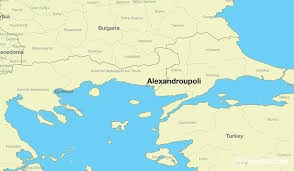How Donald Trump scrambles the general election map
The Electoral College landscape has been fairly stable over the past four presidential elections. Trump might change that.
By Steven Shepard
If Donald Trump’s coalition carries him to the GOP nomination, it could produce a crazy-quilt general election that scrambles the conventional wisdom about the battleground state map.
The Electoral College landscape has been fairly stable over the past four presidential elections: 40 states have voted for the same party in every race since 2000. But Trump’s candidacy – and a unique base of support that’s carried him to victory in places as varied as Alabama and Massachusetts — is raising the prospect of a scrambled November landscape that features long-time Democratic strongholds in play and states that have been firmly Republican for a half-century in jeopardy.
Working-class white voters have been trending more Republican over the past few presidential elections – Mitt Romney won more than 60 percent of white voters without a college degree in 2012, the most recent evolution after decades of Democratic dominance among these voters.
But at the same time, there are fewer of these voters overall. Whites without a college degree comprised just 36 percent of the electorate in 2012, according to exit polls. And a projection from the Cook Political Report shows that number could fall to under a third in 2016.
Democrats – and some Republicans – say that Trump’s alienation of growing segments of the electorate, like Hispanics, far outweighs any gains he is making among working-class whites. In their view, Democrats could pick off increasingly diverse states that have been reliably Republican at the presidential level, like Arizona and Georgia, if Trump wins the nomination. And those new blue states would help Democrats overcome any whiter states Democrats could cede, like Wisconsin or Iowa.
But consider the record turnout in GOP primaries and caucuses across the country this year – and the fact Trump has done best among working-class white voters. In the 13 states where Edison Research has conducted entrance or exit polls – all but solidly Democratic Vermont shattered set new high-water marks for turnout – Trump has performed better among white voters without a college degree in all 13, relative to his overall share of the vote.
There are a number of mostly-white states in the Northeast and Midwest to which Democrats are clinging, even as white voters have turned increasingly against them over the past few election cycles.
Polls show working-class whites could be a boon to Trump in some key states – assuming a two-way race between Trump and Hillary Clinton, the likely Democratic nominee. If a credible third-party candidate emerged – whether a moderate or a conservative – that would scramble the math considerably.
In a two-candidate race, which battleground states could trend towards Trump? Overwhelmingly white states like Iowa (93 percent of 2012 voters were white in 2012, according to exit polls), New Hampshire (93 percent), Ohio (79 percent), Pennsylvania (78 percent) and Wisconsin (86 percent) top the list. Some, like Ohio, are traditional battlegrounds. Others, like Pennsylvania and Wisconsin, have voted Democratic for decades at the presidential level.
A University of New Hampshire poll out this week shows Clinton with an 8-point lead over Trump in a hypothetical matchup – but there are some warning signs for Clinton. She trails Trump by about 15 points among non-college voters, a group Barack Obama won by 2 points four years ago.
Republicans haven’t won New Hampshire since George W. Bush carried it narrowly in 2000. But UNH pollster Andy Smith said Trump, despite his wealth, is perhaps better positioned to capture the working-class vote than Romney was in 2012, even though Romney was from neighboring Massachusetts and had a vacation home in New Hampshire.
“In New Hampshire, and also in other New England states, the Republican Party is much more of the blue-collar party,” Smith said. “Romney never really resonated with those Republicans.”
Wisconsin has been part of a Democratic blue wall for decades; the last Republican to carry the state was Ronald Reagan in 1984. And while a Marquette Law School poll released last week showed Clinton poised to carry the state over Trump, the race was neck-and-neck among less-educated voters.
“Education, at this point, is the primary driver among white voters in this state,” said Marquette pollster Charles Franklin.
Franklin added that, in Wisconsin, Trump’s coalition consists of disaffected voters who, even with Trump as a candidate, describe themselves as uncertain to vote in the general election. And a Trump-Clinton race would feed into a decade of intense partisanship in Wisconsin – with stark cultural differences between Democratic and Republican voters.
“Can he succeed in mobilizing new voters in November? When we look at our data, Trump’s supporters say they are less likely to vote than others’,” Franklin said. “I had a great illustration of that. Some anonymous caller left a voice message yesterday that complained that our poll must have only included people in Milwaukee because 80 percent of his friends in Appleton are voting for Trump.”
Trump’s appeal to working-class whites is only half the story: Democrats have been rapidly shedding these voters over the past decade or so, and Clinton has especially struggled among them in the Democratic primaries and caucuses thus far. Most of the contests Bernie Sanders has won thus far have been in whiter states.
That stands in contrast to 2008, when Clinton feasted on whiter states, like the critical battleground state of Ohio.
Clinton “drew quite well from white, working-class Democrats” in the 2008 primary, said Ohio State University professor Paul Beck. “That was more her constituency than it was Obama’s at that point in time.”
But that’s flipped in this primary. Sanders basically tied Clinton in the Iowa caucuses, won the New Hampshire primary and caucuses in Colorado, Kansas, Maine and Nebraska.
Beck said he didn’t expect a Clinton-Trump race to scuttle Ohio’s bellwether status, but he said Trump could crack traditionally Democratic, though culturally conservative, areas of the state. A number of counties in eastern and southern Ohio voted twice for Bill Clinton – but flipped for George W. Bush and have continued trending more Republican, even as Obama carried the statewide vote in both 2008 and 2012.
“I think Ohio still would be a battleground just based on the division of partisans in the state,” said Beck. “It will be interesting to see how Trump plays in that battleground. I expect him to do better [in southern Ohio], but traditional Democrats aren’t doing well in the south anyway.”



















